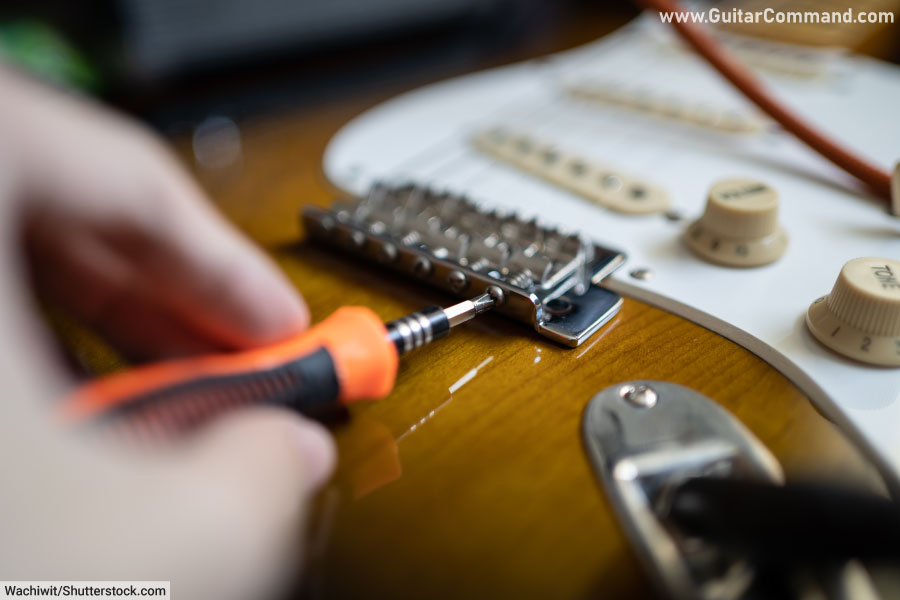Guitar intonation adjustment involves testing the intonation of each string by comparing the fretted 12-fret octave with the harmonic produced at the same fret. If the fretted note is sharp, the string needs to be lengthened; if the fretted note is flat, then the string needs to be shortened.
The way in which the length of the strings is adjusted depends on the type of bridge fitted on your guitar. In our guide to adjusting electric guitar intonation, you’ll find out how to adjust intonation on a range of guitar bridge styles...
Is My Guitar’s Intonation Out?
Here’s a common guitarist’s conundrum...
You plug in your prized axe. Your pedals are on, your amp is humming, and you unleash a rib-cracking open A chord, but something’s not quite right. You check your tuning, and the tuner says all your strings are in tune, so you try again. Maybe another chord a little higher up on the neck, like a nice, rich barre chord at the fifth fret. To your horror, the barre chord is even uglier! What gives?

You probably need to check out your guitar’s intonation...
Page Index
How To Check Guitar Intonation
Tools Needed To Adjust Guitar Intonation
How To Adjust Electric Guitar Intonation
Wraparound and Stoptail Bridges
What Is Guitar Intonation?
Guitar intonation is how well a guitar is in tune with itself. A guitar with poor intonation will be out of tune in certain fretboard positions, even if the open strings are in tune. A guitar with good intonation will be in tune all over the neck.
If you’ve ever felt like your guitar’s just a little out of tune, even though you’ve freshly tuned it, you might be having intonation issues. Sometimes, the open notes sound spot on, but as you get further up the neck, chords start to sound dissonant, and fretted notes come in just a little sharp or flat.
Another good indicator of poor intonation is the twelfth fret harmonic being anything other than a perfect octave above the open note of a correctly-tuned string.
In either of these cases, it's time to fix your guitar's intonation!
Fortunately, we’ve put together this handy guide to adjusting your guitar intonation so you'll be able to get your guitar sounding great again in no time!

How To Check Guitar Intonation
The first task is to double-check that you actually need to adjust your guitar's intonation.
To check your intonation, you’ll need your guitar, a lead, and a reliable tuner.
First of all, you’re going to tune the guitar. Plug it into the tuner, turn it on, and tune the guitar as you usually would. For most of us, this means standard tuning E-A-D-G-B-E.
You can use a tuner app or clip-on tuner if you want, but most of the best guitar tuners (such as the Boss TU-3, below) require you to plug the instrument in.
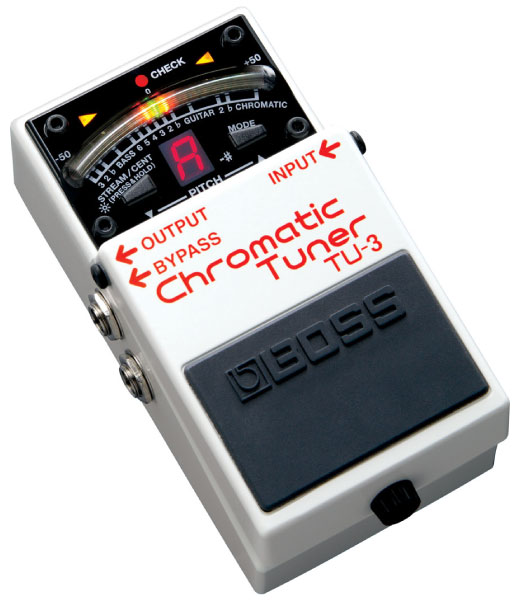
Once the guitar is tuned, you’re going to play a natural harmonic at the twelfth fret. If you haven’t done this before, lightly touch your guitar string directly above the 12th fret wire (i.e. don’t press down between the frets as you would do when playing a “normal” note).
Pluck the guitar string with the other hand to produce the harmonic, which should have a soft, rich, ringing tone. Check your tuner to see how well the harmonic tone is in tune.
The harmonic should be perfectly in tune. If it isn't, adjust the tuning of that string until it is.
Now play the fretted 12th note of the string normally. Is this note perfectly in tune with the natural harmonic? Check your tuner.
If the fretted note is higher or lower than your harmonic, your intonation is out, and you’ll need to adjust it. Repeat the process for each string, noting whether the fretted note is sharp (higher than the harmonic) or flat (lower than the harmonic).
The direction in which you adjust the string depends on whether the fretted note is sharp or flat.
If your fretted note is perfectly in tune with the harmonic, the string is correctly intonated.
If the same can be said for all of the strings, congratulations! Your intonation is perfect and no adjustment is necessary!
Guitar Parts For Adjusting Intonation
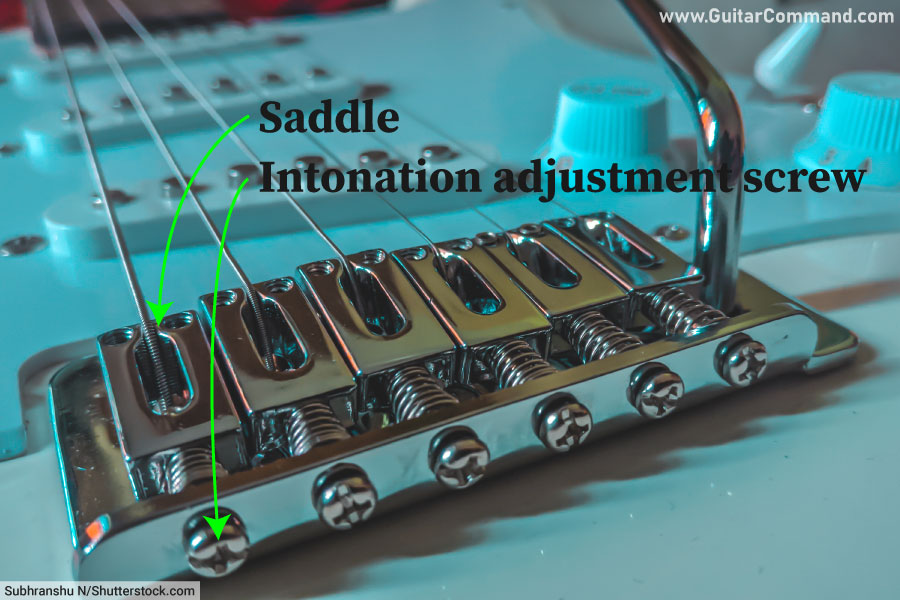
In order to adjust your intonation, you’ll need to locate the following parts of your guitar:
- Bridge
- Bridge saddles (the parts of the bridge over which the string actually passes)
- Saddle adjustment screws
Broadly speaking, when it comes to electric guitars, there are four main types of bridge:
- Fender-style bridge
- Gibson-style bridge
- Wraparound, or Stoptail bridge
- Floyd Rose bridge
Of these, Fender and Gibson style bridges are the most common. The wraparound bridge is really just a variation on the Gibson style bridge, but it requires a different adjustment process so we’ve listed it separately.
Intonation adjustment of Floyd Rose bridges is more complex, but still perfectly achievable by anyone with a bit of patience!
Directions for adjusting the intonation for each of these main styles are provided below.
Tools Needed To Adjust Guitar Intonation
You don’t need any super-special luthier’s tools to adjust your guitar intonation. In most cases, a small screwdriver will do just fine.
Generally speaking, guitars use small, Phillips-head screws, so if you have a small Phillips screwdriver it should be okay, although it's always best to use exactly the right size screwdriver to prevent damage to the screws.
Some guitars require a flat head screwdriver. Locate the intonation adjustment screws (see photos further down the page) on your guitar, and use the appropriate tool.
Floyd Rose-style locking tremolo systems will require an allen key (also known as a hex key or Allen wrench) for intonation adjustment. Most Floyd Rose systems require a 2.5mm allen key.
To make intonation adjustment (and a variety of other guitar fixes) easier, you could purchase a guitar multi-tool such as those produced by Ibanez and Ernie Ball.
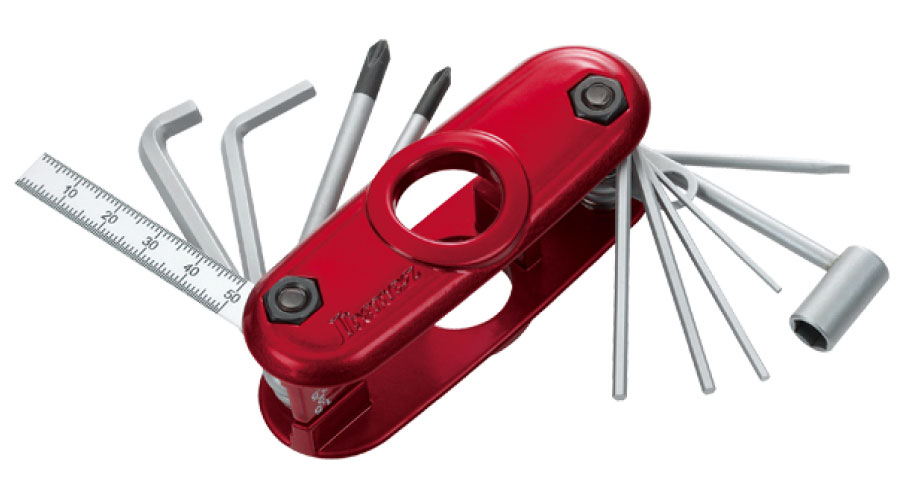
A new set of strings, together with a wire cutter and string winder (or handy combined device that does both) sitting around will prevent delays should you accidentally break a string while fixing your intonation.
A tool such as the D'Addario Pro Winder can vastly speed up your string changes.
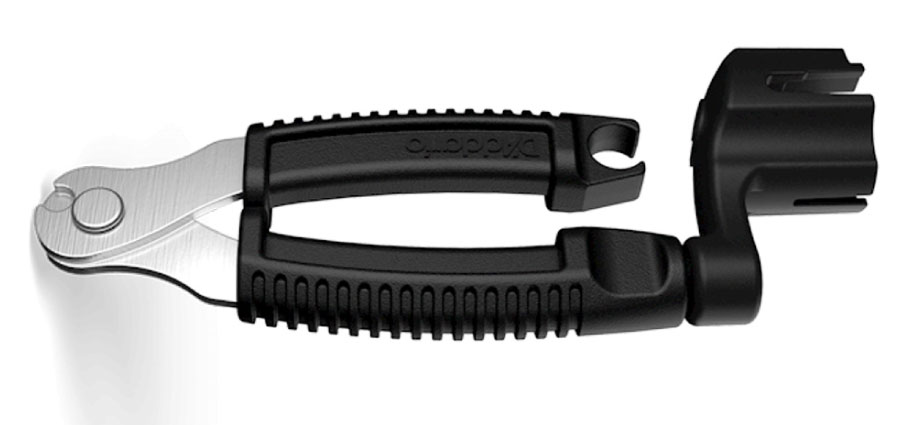
How To Adjust Electric Guitar Intonation
Adjusting guitar intonation involves adjusting the length of your guitar strings, no matter which type of bridge you’re using.
- If your fretted note is sharp compared to the harmonic, you need to increase the length of the guitar string.
- If the fretted note is flat compared to the harmonic, you need to shorten the length of the string.
To alter the length of the guitar string, you adjust the bridge saddle, moving it either further away or closer to the fretboard. This is done by turning the adjustment screws.
You’ll want to make these adjustments slowly and gradually, using your tuner to check that you are turning the screw in the correct direction.
- Increasing the length of the string will lower the pitch of the fretted note.
- Decreasing the length of the string will raise the pitch of the fretted note.
Click on your type of bridge to see how to adjust the intonation of your guitar...
- Fender-style bridge intonation adjustment
- Gibson-style bridge intonation adjustment
- Wraparound, or Stoptail bridge intonation adjustment
- Floyd Rose bridge intonation adjustment
Fender Stratocaster Intonation Adjustment
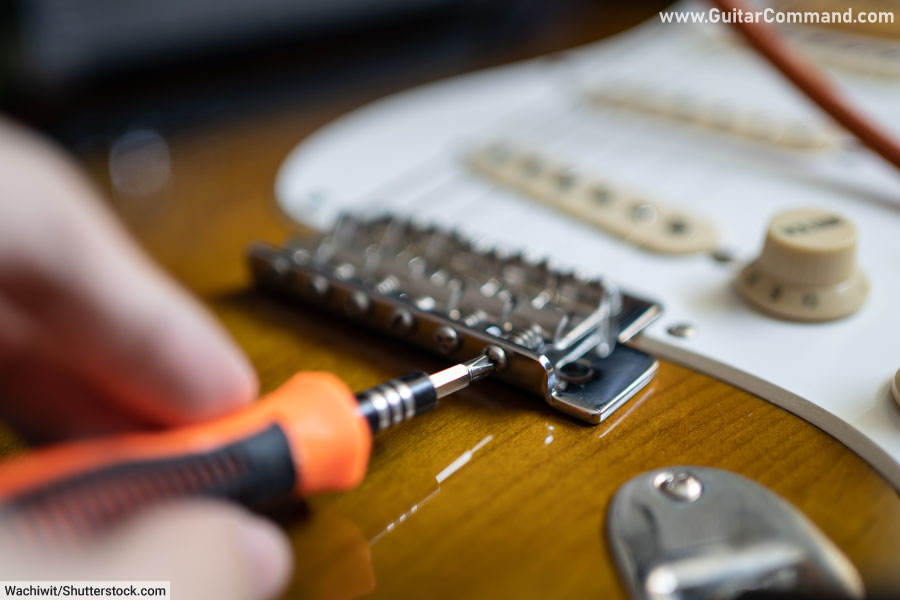
Most modern Fender bridges feature six saddles (one for each string) and a string-through-body mechanism. You can adjust the screw of each saddle to adjust your intonation.
A clockwise turn of the screw will increase your string length, while an anticlockwise turn will decrease the string length.
It follows, then, that if your fretted note on the twelfth fret is sharp, you’ll want to use a clockwise turn, and if it’s flat, use an anticlockwise turn.
Only do a quarter turn at a time, and check the guitar’s intonation each time. A little bit can go a long way.
Old-Style Telecaster Intonation Adjustment

Old-style Telecasters have a two strings per saddle bridge system. This means that instead of adjusting the intonation of each individual string, you have to adjust the intonation of two strings at once.
As a result, you may not find it possible to achieve perfect intonation on both strings. As a compromise, you may have to adjust the saddle to the best in-between position.
Gibson Intonation Adjustment

With Gibson Tune-O-Matic style bridges, each string passes over a small saddle and ends at a tailpiece, rather than running through the body as with a Fender guitar.
With a Gibson-style bridge, you decrease string length with a clockwise turn of the screw, and increase it with an anticlockwise turn.
Accordingly, if your fretted note is flat, use a clockwise turn, and if it’s sharp, use an anticlockwise turn.
On some Gibson-style bridges, the adjustment screws face the other way on the bridge. Whatever type of bridge you have, always start with small turns to see which way the saddle is moving.
Wraparound and Stoptail Bridges
If your guitar has a PRS-style wraparound bridge, its strings will wrap over the bridge and through to the other side.
This bridge should have adjustable screws on the pickup side of the bridge, which can make them harder to access.
The saddle mechanism, however, is the same as Gibson’s. For a flat fretted note, use a clockwise turn of the screw to decrease your string length. For a sharp fretted note, turn the string anticlockwise to increase the string length.
Older-Style Fixed Bridge
If your bridge lacks individual saddles, and instead has a simple, non-adjustable bridge, you won’t be able to adjust the intonation of individual strings. This type of bridge usually has an intonation adjustment screw at either side of the bridge for general adjustment of all of the strings.
Without individually adjustable saddles, it’s harder to achieve perfect intonation for each string. Instead, the aim is to achieve the best average intonation across all of the strings by adjusting the angle of the bridge using the treble and bass screws.
As an example, if your treble strings are sharp, a clockwise turn of the screw on the treble side of the bridge will increase your string length for all three strings.
By adjusting the overall intonation in this manner, a perfectly useable intonation can usually be achieved.
Unless you’re using a very old guitar, you probably don’t have to deal with this type of bridge. If you do have this type of bridge, and you're finding that inaccurate intonation is becoming a problem, you could always purchase a new bridge with adjustable saddles.
Floyd Rose Intonation
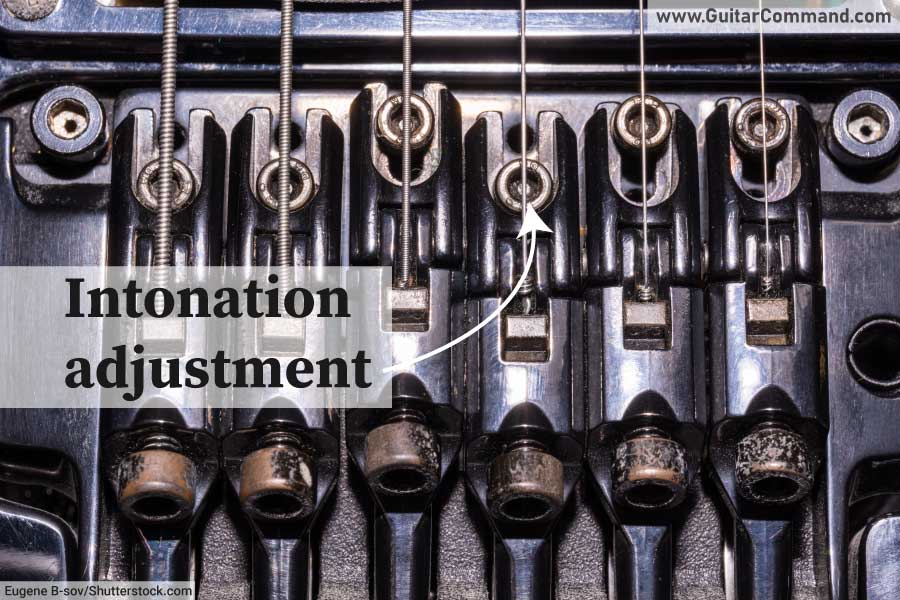
If your guitar has a Floyd Rose bridge, you’ll be able to fine-tune each string’s intonation, albeit with some awkward maneuvering.
Each saddle is held in place by a hex nut. You’ll need to loosen this nut to move the saddle back or forward, tightening it again to check the guitar’s intonation once more.
You’ll usually need to de-tune a string in order to be able to move the saddle beneath it, then re-tune the string to test the tuning.
This makes adjusting the intonation of a Floyd Rose-equipped guitar quite an arduous task.
It’s the price we pay for unleashing dive-bombs and Van Halen-style elephant sounds on the guitar!
Conclusion
Adjusting the intonation on an electric guitar is a relatively easy job that usually doesn’t require any specialized tools.
A guitar’s sound and playability are often greatly improved with correct intonation. Adjusting a guitar’s intonation is a great way to make a cheap or unloved instrument playable.
If you have an important recording session or live show coming up, it’s definitely worth checking your guitar’s intonation and adjusting as necessary!
Related Pages on Guitar Command
How To Clean An Electric Guitar: Step-By-Step Guide With Photos

